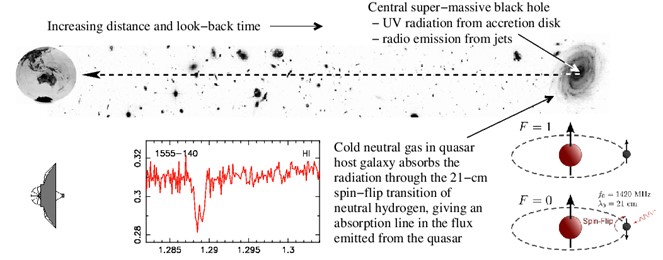The star forming material in the distant universe
Find out about our study of cold hydrogen gas, the fuel for all star formation, in the far reaches of Universe.
Hydrogen gas gives the Universe its heat and light, providing the raw material for the formation of stars. While stars themselves are hot, they can only form from the coldest gas (10 degrees above absolute zero), in which a giant (light-year) cloud of hydrogen can collapse under its own gravity, before attaining sufficient pressure to undergo the thermonuclear fusion which ignites the proto-star.
Since the fusion of hydrogen into heavier elements over the course of the star’s lifetime (billions of years) is the only way to produce the materials which make up our planet and own bodies (silicon, carbon, oxygen, etc.), the study of cold hydrogen in the distant and most ancient reaches of space is crucial to our understanding of how the present-day Universe came to be.

At redshifts z > 0.1 (a look-back time of ~1 billion years), HI is detected through the absorption of a background source. This can arise from a galaxy intervening the radio emission from a more distant quasar, or associated with the gas within the host galaxy of a quasar. At redshifts of z > 1, we are looking back beyond 7 billion years, before the peak of consumption by star formation, but, for both associated and intervening absorption, find a surprising deficit of hydrogen in comparison the local Universe.
Our research focus is finding this missing gas, which can not only tell us how the distant (and therefore early) Universe is populated, but the absorption spectra can provide a unique probe of the values of the fundamental constants of nature at large look-back times.
Further information see thespaced.com
